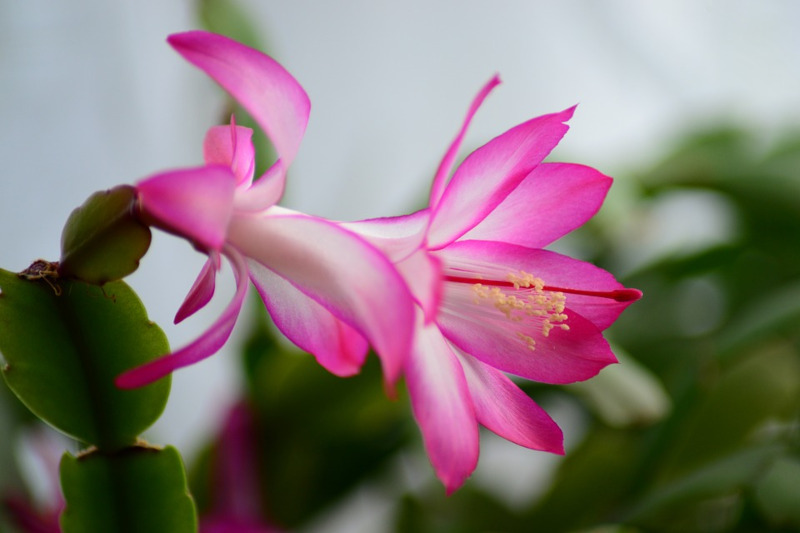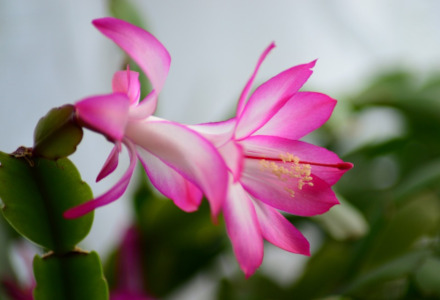
Public Domain Image
Christmas Cactus Facts
- Firstly, perhaps the most noteworthy attribute of the fabulous Christmas Cactus remains one that might surprise most people. Secondly, that surprising attribute is the fact that this beautiful and distinctive plant typically actually blooms during the Christmas season.
- However, the distinctiveness of this particular plant does not end there. That’s because yet another interesting fact remains concerning this remarkable species. As a result of evolving in its particular habitat, this particular variety of cactus grows on trees or rock outcroppings.
- Furthermore, due to its tendency to bloom during the season of Christmas, the genus has spread far beyond its endemic range. Rather understandably, it became quite popular as an ornamental plant. This fact holds especially true of its presence in gardens and as a houseplant.
- Finally, only 6 known related species comprise this somewhat small but beautiful genus. Additionally, not to mention amazingly, all of them inhabit the same highly restricted endemic habitat range. Sadly, its natural habitat currently remains quite vulnerable to climate change.
Related Species
Century Plant Euphorbia Caput Medusae Old Woman Cactus
Public Domain Image
Christmas Cactus Physical Description
First of all, in its natural habitat, the magnificent Christmas Cactus most commonly takes the form of a rather large shrub. As a result, the thick, woody base of each plant attains an average height of about 4 ft (1.2 m). The wonderful plant also typically grows quite wide in relation to its height.
The stems typically resemble leaf-like pads and display a beautiful dark green color. Much as other cacti, the plant does not produce any leaves. Yet, the numerous flowers appear in large numbers and a truly wide range of colors. These colors include yellow, white, pink, red, orange, and even purple.
Furthermore, these beautiful blooms only develop at either the tips or joints of the many stems. In addition, the small, delicate fruit also has a rather surprising fleshy consistency. Finally, the tiny black seeds of this amazing species remain extremely small, measuring less than 1 mm in size.
- Kingdom: Plantae
- Phylum: Angiosperm
- Class: Eudicots
- Order: Caryophyllales
- Family: Cactaceae
- Genus: Schlumbergera
Christmas Cactus Distribution, Habitat, and Ecology
First of all, the spectacular Christmas Cactus occurs naturally in only one particular region of the world. That restricted range consists of the coastal mountains of southeastern Brazil, in South America. This specifically includes the states of Rio de Janeiro, Sao Paulo, Minas Gerais, and Espirito Santo.
In addition, even in this highly restricted region, the fascinating species exhibits extreme selectivity in its choice of habitat. That’s because, in this location the plant appears almost exclusively on either trees or rocks. In addition, these areas must also possess both shade and high humidity.
At the same time, the Christmas Cactus only appears to grow at a select range of altitude. This covers elevations ranging between 2,300- 9,120 ft (700 – 2,780 m). But, it has an evolutionary reason for this selectivity. Its unique location provides it with warm, moist air, forced upwards to its location.
The amazing species also developed a unique dependency upon local bird species. Its tiny seeds do not release spontaneously when the fruit ripens, like many plants. Therefore, it generally relies upon the birds to spread them after consuming the fruit. However, the plants occasionally reproduce via vegetative propagation, as well.
Species Sharing Its Range
Check out our other articles on Earth’s Extremely Threatened Flowers, Lonar Lake, Western Pygmy Blue, Loggerhead Sea Turtle, California red-sided garter snake

